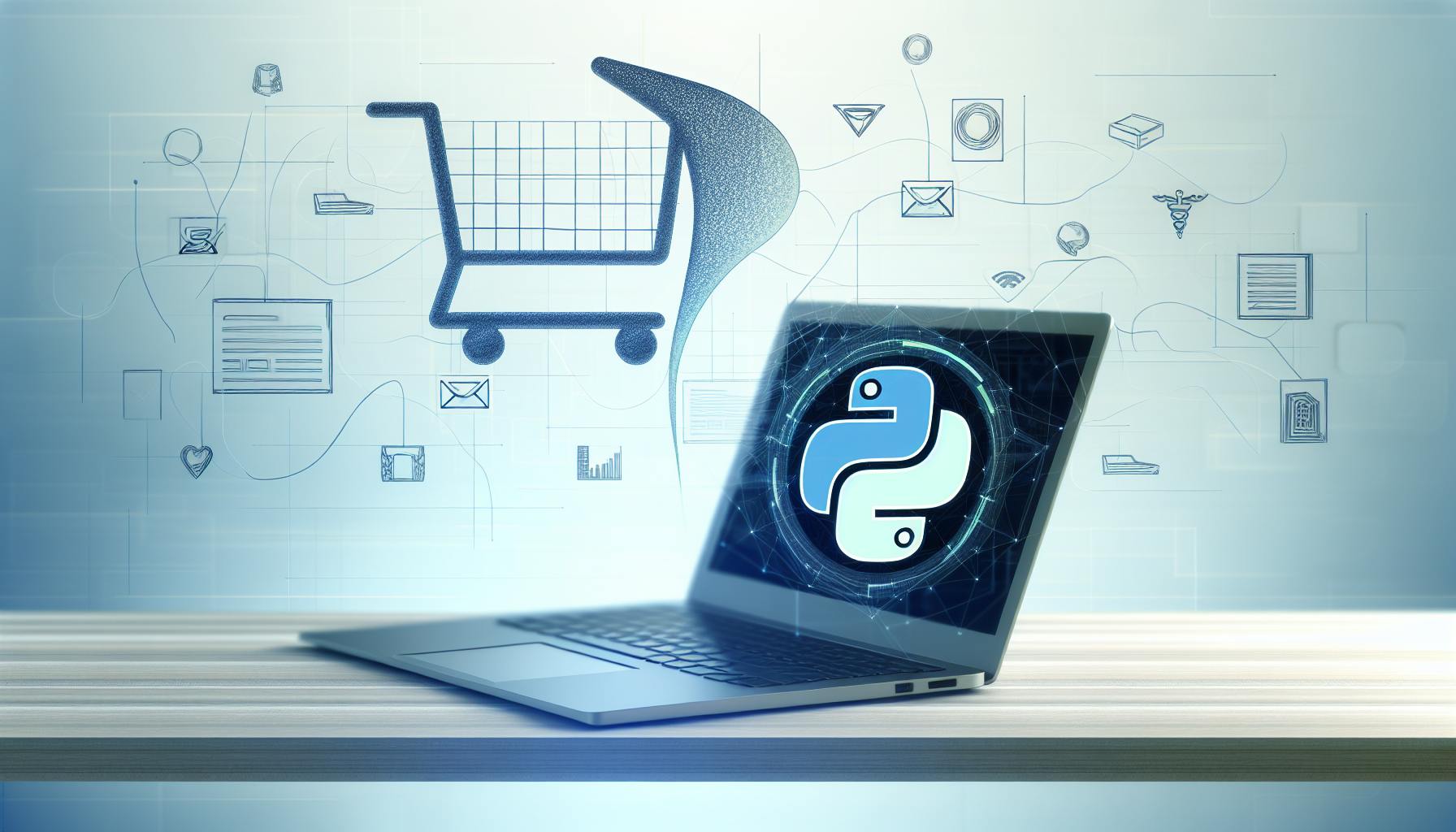Invoicing and billing are often tedious manual processes for service businesses.
Automating these critical back office functions with Python can save significant time and money while enabling businesses to scale.
This article will demonstrate step-by-step how to leverage Python automation for streamlined billing workflows. You'll learn how to generate personalized invoices from templates, calculate totals and apply discounts automatically, and convert invoices to shareable PDF formats.
Introduction to Office Automation in Billing
Automating billing and invoicing processes with Python can provide significant efficiency gains for service-based businesses. By leveraging Python's capabilities for automating document creation, calculations, reporting, and more, companies can save time and money compared to manual billing operations.
This article will cover the key benefits of automating billing with Python in service industries and provide an overview of critical invoice components that can be generated programmatically. We'll also look at common pain points of manual invoicing and how automation helps businesses overcome these frustrations.
Overcoming Manual Invoicing Challenges in Service Industries
Manually creating invoices in service industries often leads to:
- Time wasted typing up billing documents for each client engagement
- Difficulty tracking billable hours across projects and employees
- Calculation errors happening frequently without checks
- Inability to quickly generate reports for accounts receivable
Automating with Python allows businesses to:
- Instantly create customized invoices from templates
- Seamlessly pull in billable hours data
- Calculate totals, taxes automatically
- Generate financial reports on demand
This removes significant administrative burden for service teams and minimizes human error risks.
Core Components of an Automated Invoice
Key elements to include on every system-generated invoice:
- Unique invoice number
- Date issued
- Client name & address
- Line items with detailed project descriptions
- Billable hours or service quantities
- Unit prices & extended totals
- Tax rates, discounts, final totals
- Company header & payment terms
Python automation allows this standardized information to populate quickly according to preset business rules. Features like bulk invoicing and batch reporting are also available for added productivity gains.
How do I automate my invoicing?
Automating invoicing can save businesses significant time and effort. Here are some tips to get started:
Use invoice templates
- Start with a template in Word, Excel, Google Docs or other software that includes your logo, company details, etc.
- Customize it to match your typical invoices so the format is consistent.
Build workflows
- Map out the steps involved in creating and approving invoices in your company.
- Identify parts of the process that can be systematized.
Leverage automation software
- Accounting tools like QuickBooks, Xero or FreshBooks enable creating recurring invoices.
- Approval workflows can be set up in these or separate software.
- Integrations with CRMs, POS systems etc. can pull data to populate invoices.
Customize with scripts
- Languages like Python can generate PDF invoices from templates programmatically.
- Scripts can also automate sending invoices via email or integrate with other systems.
Start small
- Pick a part of invoicing like approvals or reminders to automate first.
- Slowly expand automation to cover more of the invoicing process over time.
The key is mapping out current workflows, identifying areas for automation and then utilizing the right tools, whether off-the-shelf or custom-built, to systematize various aspects of invoicing. Start small for a smooth transition.
How do you make a bill generator in Python?
To build a bill generator in Python, follow these key steps:
Import Required Modules
Import modules like datetime, io, reportlab, xlsxwriter, and PIL to enable various functionalities:
datetime- for date operationsio- for file I/O operationsreportlab- for PDF generationxlsxwriter- for Excel file creationPIL- for image processing
Build GUI for Input
Design a graphical user interface (GUI) using Tkinter or PyQt to collect required billing details from the user. This includes fields like:
- Customer name
- Invoice date
- Product details
- Description
- Quantity
- Rate
- Amount
- Tax
- Additional charges
- Total amount
Generate Invoice PDF
Define a function to take inputs from GUI, calculate totals, create invoice layout using ReportLab library and generate a PDF file with name containing invoice number and date.
Key steps are:
- Set page layout - size, orientation, margins
- Add sender/client details
- Insert logo
- Print product table
- Insert terms and conditions
- Calculate totals and print
- Save PDF with unique name
Other Functions
Additional functions can be added for features like:
- Choosing invoice date from calendar
- Uploading signature image
- Sending invoice via email
- Converting to Excel/Word formats
By following these steps, you can automate billing and invoicing using Python. The modular structure also allows enhancing as per specific business needs.
Can invoice processing be automated?
Automating invoice processing can help businesses save significant time and money. Here are some of the key benefits:
Streamlined Workflow
Automated invoice processing extracts data from invoices and populates it directly into your accounting or ERP system. This eliminates the need for manual data entry, allowing your team to focus on more value-added tasks.
Improved Accuracy
Manual data entry often leads to errors. Automation ensures information is captured accurately every time, improving overall data quality.
Faster Processing
Automated systems can process invoices much faster than humans. This leads to quicker customer payments and improved cash flow.
Enhanced Reporting
With a digital workflow, it's easier to track and report on invoices. You gain more insight into customer payment patterns and areas for efficiency gains.
Reduced Fraud Risk
Automating approvals with pre-defined business rules reduces the risk of fraudulent or inaccurate invoices slipping through.
With the right software, automating invoice processing is easy to implement. Focus on solutions that integrate with your existing systems and provide dashboards to monitor productivity gains.
How do I create an e invoice in Python?
Creating electronic invoices (e-invoices) in Python involves a few key steps:
Import Necessary Modules
First, import the modules you'll need to generate PDF documents and work with data:
import pdfkit
import pandas as pd
pdfkitallows creating PDFs from HTMLpandashelps wrangle invoice data
Create Invoice Template
Next, design an HTML template for your invoice that includes areas to insert customer data, invoice number, dates, line items, totals, etc.
For example:
<div id="invoice-template">
<h1>Invoice # {inv_num}</h1>
<p>Date: {date}</p>
<p>Customer Name: {name}</p>
<!-- Additional template sections -->
</div>
Get Invoice Data
Then, get the actual invoice data you want to include, such as by loading it from a CSV file or database:
df = pd.read_csv('invoice_data.csv')
Generate PDF Invoice
Finally, fill in the template using the data and output a PDF file:
pdfkit.from_string(filled_template, 'invoice.pdf')
This allows automating invoice creation in Python without repeatedly designing documents.
Some additional tips:
- Use ReportLab to build more complex PDF layouts
- Integrate with Excel to load data
- Set up a function to reuse for multiple invoices
Let me know if any part needs further explanation!
sbb-itb-ceaa4ed
Setting the Stage for Automating Invoicing with Python
Automating invoicing can save service businesses time and money. Python provides powerful, flexible tools to create customized invoicing systems. This section outlines key steps for setting up Python to generate automated invoices.
Choosing the Right Python Libraries
The ReportLab library enables creating complex PDF documents like invoices in Python. Features include:
- Formatting text with different fonts, sizes, colors
- Adding images and logos
- Controlling page layout and sizes
- Drawing lines, rectangles, circles
- Generating multi-page documents
Other useful Python libraries:
- Pandas - for reading and analyzing Excel billing data
- NumPy - for numerical data processing
- docx - for generating Word documents
When combined, these libraries allow automating every aspect of invoice generation.
Python Excel Integration for Billing Data
Python makes it easy to connect billing systems to Excel spreadsheets. The Pandas library provides functions like:
read_excel()- load Excel data into Pandas DataFramesto_excel()- write DataFrames out to Excel files
This enables:
- Loading customer, product, pricing data from Excel
- Reading order data from Excel to populate invoice details
- Writing generated invoices back out to Excel reports
With Python's Excel integration, billing data can flow automatically between systems.
Establishing a Recreate Invoice Function
A reusable recreate_invoice() function is key for automating recurring invoices. It should:
- Accept customer ID and billing period as inputs
- Load customer and order data for that period from Excel
- Populate invoice template with values programmatically
- Output completed PDF invoice with unique invoice number
Additional parameters could customize invoice behavior for different customers.
By encapsulating invoice generation logic into a function, invoices can be recreated on demand or on a schedule for recurring customers.
Creating Invoice Templates in Python
Generating professional invoices is critical for service businesses. Python offers flexible tools to automate invoice creation, saving time and effort. This guide will demonstrate practical techniques to programmatically design invoice templates.
Creating Word Docx File for Invoice Layout
The python-docx library allows generating Word documents for invoices. We can define data structures with invoice details and populate templates:
import docx
from docx.shared import Cm
invoice = {
"number": "INV-001",
"date": "02/14/2023",
"client": "ABC Company"
}
doc = docx.Document()
doc.add_heading("Invoice "+invoice["number"], 0)
doc.add_paragraph(
"Date: " + invoice["date"] + "\n"
"Client: " + invoice["client"]
)
doc.save('invoice_example.docx')
This renders a simple invoice Word doc with the invoice data. Additional elements like tables can be added to customize templates.
Designing the Invoice: Setting Page Layout and Font Settings
Page layouts, text formatting, and styling can be configured in Python:
section = doc.sections[0]
section.page_height = Cm(29.7)
section.page_width = Cm(21)
section.left_margin = Cm(2)
section.right_margin = Cm(2)
font = doc.styles['Normal'].font
font.name = 'Arial'
font.size = Pt(10)
This sets page size, margins, and default text formatting. Fonts, colors, paragraph alignments can also be customized.
Automating Invoice Number Generation and Date Formatting
Unique invoice numbers can be generated and dates formatted automatically:
import datetime
from random import randint
today = datetime.date.today()
invoice_date = today.strftime("%m/%d/%Y")
invoice_number = f"INV-{today.year}-{randint(100,999)}"
date.today() provides current date, strftime() formats it, and random integers create unique invoice codes.
Importing Images and Logo to Personalize Invoices
Company logos visually identify invoices:
from docx.shared import Inches
logo = doc.add_picture('logo.png', width=Inches(1.5))
logo.alignment = WD_ALIGN_PARAGRAPH.CENTER
This inserts a logo image to the template and centers it. Various image types are supported.
These examples demonstrate practical techniques to automate custom invoice generation with Python. The flexible python-docx library combined with Python's date/text handling makes creating professional invoices easy.
Enhancing Invoice Details with Python
Python provides powerful capabilities to enrich invoice details with service descriptions, line items, discounts, and accurate totals.
Adding Invoice Description and Service Details
- Use string concatenation and f-strings in Python to include descriptive headings and service details in the invoice body. For example:
service_desc = "Social Media Management"
invoice_body = f"Services Provided: {service_desc}"
- Create a
listofdictionariesto define line items, with keys for item names, descriptions, quantities, rates etc. Loop through to add each item.
line_items = [
{"name": "Content Creation",
"desc": "Writing blog posts",
"quantity": 10,
"rate": 20
}
]
for item in line_items:
invoice_body += f"\n{item['quantity']} x {item['name']} - {item['desc']} at {item['rate']} per unit"
Applying Discounts and Calculating Totals
- Use
if/elselogic to check conditions and apply discounts to line item rates.
if order_size > 100:
rate *= 0.9 # Apply 10% discount
- Sum the line amounts to produce a total, storing in a variable like
total_amount. - Subtract discounts from
total_amountto get the final invoiced total. Output this clearly.
Total before discounts: $1000
Discounts: -$100
Final Total: $900
Python enables detailed and accurate invoice generation with its versatile data structures and processing capabilities.
Converting Invoices to PDF Format
Converting invoices to PDF format offers several benefits. PDFs are universally accessible across devices and operating systems. They preserve formatting, ensuring invoices look professional and polished regardless of who views them. PDFs are also secure, helping to protect sensitive customer and payment information.
Creating PDF File from Word Document
To convert a Word document invoice to PDF using Python:
- Import the
docxlibrary to read Word files and thepdfkitlibrary to generate PDFs - Open the Word invoice with
Document() - Extract the text and styles using
document.paragraphsanddocument.styles - Create a new PDF with
PDFKit() - Recreate the invoice by adding text paragraphs and applying styles
- Save the PDF file
This process extracts content while retaining layout and formatting. The resulting PDF invoice is an accurate recreation of the original Word document.
Setting Canvas and Page Size for PDF Invoices
When generating PDF invoices, explicitly set the canvas and page size by passing parameters to PDFKit():
pdf = PDFKit(pagesize=(W, H), pageoptions={'margin-top': M})
Where:
WandHdefine the width and heightmargin-topsets the top margin
Settings like W, H, and M should match the Word document to accurately recreate its dimensions.
Configuring page size and margins ensures PDF elements position correctly without overflowing. This presents a professional invoice formatted for printing or digital use.
Streamlining Billing Workflows in Service Industries
Automating billing and invoicing workflows can help service industries like law firms, creative agencies, and IT consultants improve efficiency and cash flow. Python provides several libraries to integrate automation into existing accounting systems.
Connecting Python Automation to Existing Billing Systems
Python scripts can connect to platforms like QuickBooks Online and Zoho Books using their REST APIs. For example:
import quickbooks
client = quickbooks.QuickBooks(
sandbox=True,
consumer_key='CONSUMERKEY',
consumer_secret='CONSUMERSECRET',
access_token='ACCESSTOKEN',
access_token_secret='TOKENSECRET',
company_id='COMPANYID'
)
new_invoice = client.Invoice()
new_invoice.Line.append(
DetailType='SalesItemLineDetail',
Amount=100,
Description='Consulting services',
)
new_invoice.save()
print(new_invoice.Id)
This allows creating invoices, connecting them to clients, adding line items, applying discounts, etc directly from Python scripts.
Automating Invoice Delivery and Payment Processing
To email invoices directly from Python, libraries like yagmail, smtplib or pdftotext can be used. For example:
import yagmail
yag = yagmail.SMTP('mygmailusername', 'mygmailpassword')
contents = [
'This is the body, in plain text',
'/local/path/to/invoice.pdf'
]
yag.send('recipient@somedomain.com', 'Invoice', contents)
For online payments, the Python Requests library integrates with payment gateways like Stripe, PayPal, Square or Braintree.
This allows streamlining the entire billing workflow - from invoice creation to delivery to payment collection. Python automation helps improve accounting efficiency.
Conclusion: Embracing Automated Billing with Python
Automating billing and invoicing with Python provides numerous benefits for service industries:
Increased Efficiency
- Automation eliminates manual data entry and calculations, saving significant time and effort. Python scripts can quickly generate customized invoices tailored to each client.
Enhanced Accuracy
- Automated systems help minimize human error in billing tasks. Calculations are handled precisely through code, reducing mistakes.
Better Reporting
- Python offers easy integration with databases to track invoices. This enables detailed financial reporting and analysis.
Customization
- Python allows full control to add custom fields, apply discounts, set templates, and tailor invoices to your business needs.
Scalability
- With Python automation, your system can smoothly handle increasing invoice volumes as your client base grows.
Next Steps in Automating Your Service Industry's Billing
To get started with Python billing automation:
- Check out the Invoice Generator Template on GitHub
- Review Python libraries like ReportLab for PDF generation
- Follow this Invoice Automation Tutorial with code samples
Automating billing is a key step to streamline operations. Python provides the flexibility and power to customize your invoicing system.


